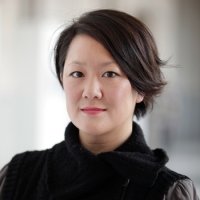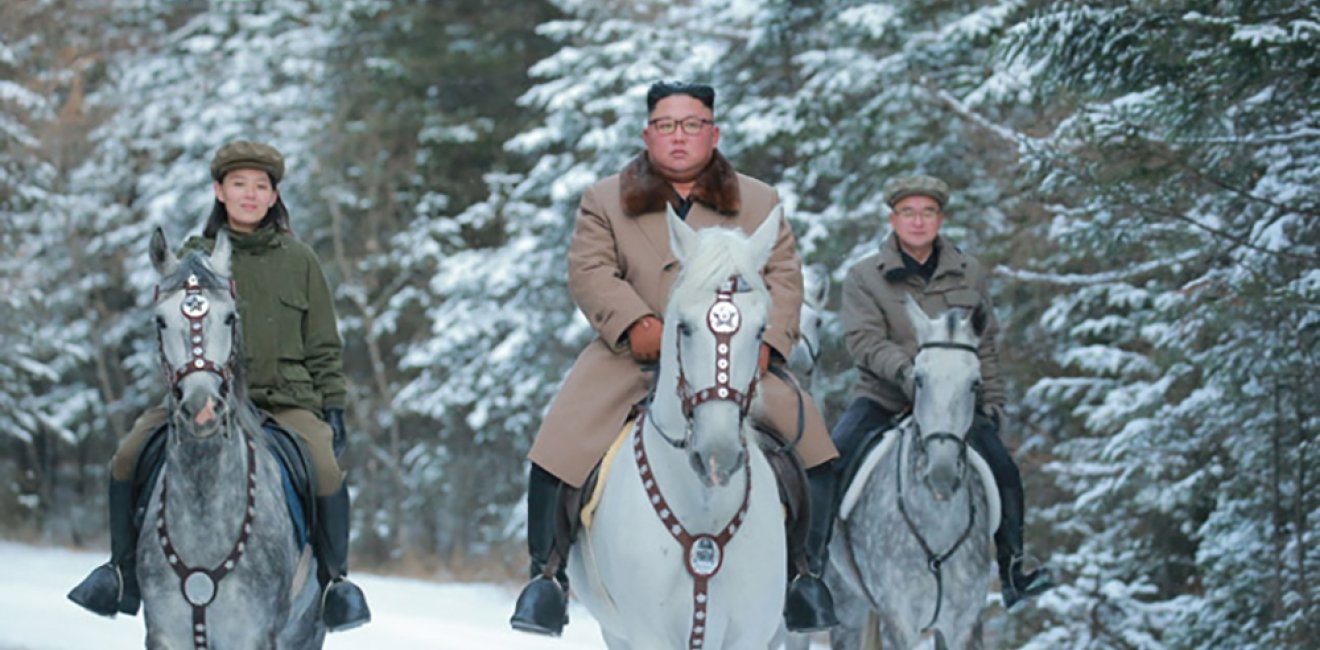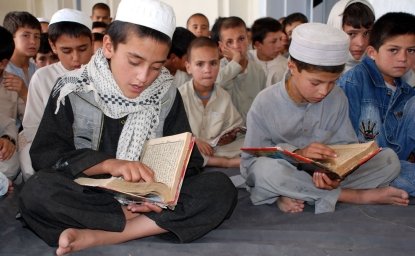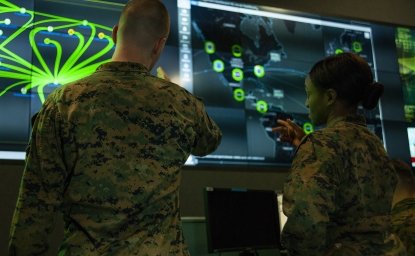
A blog of the Indo-Pacific Program
Kim Jong Un on a white horse, galloping through the snowy mountains at top speed, fog and mist rising behind him. Kim Jong Un leading the charge up a steep mountain, like a general leading warriors heading off to battle. Kim Jong Un lost in thought as he rides solemnly through the forests of Mount Paektu, his sister at his side.
The over-the-top images posted to North Korean state media this month provided plentiful fodder for Internet memes, not unlike the photos of Russian President Vladimir Putin bare-chested on horseback.
But the recent images of Kim, in all their bombastic and excessive glory, offer more than just humor: They also give us a glimpse into the making of Kim’s mythology as well into the psychology of his decision-making at a time when his frame of mind and future plans remain opaque.
They may be comic to foreigners but North Koreans will immediately understand the messaging.
The photos of Kim astride a majestic white horse in snowy Mount Paektu are meant to project an image of strength. They may be comic to foreigners but North Koreans will immediately understand the messaging. Mount Paektu, a dramatic volcanic mountain in the far north, is considered sacred to Koreans on both sides of the DMZ because it is said to be the birthplace of the Korean people. Legend has it Tangun (transliterated as Dangun in South Korea) descended from Paektu in 2333 BC to become the mythological “founder” of the Korean race.
Kim’s grandfather, Kim Il Sung, borrowed from that mythology in creating his cult of personality by weaving a mythology that places the Kim family in Paektu. Kim Il Sung claimed to have fought a guerrilla war against the Japanese from the forests of Mount Paektu. He considered Paektu so central to his rise to rule that the lake in the crater of the live volcano at Paektu, Chonji, is featured on the cover of his autobiography. The mythology has his wife giving birth to son Kim Jong Il at the foot of Paektu (records, however, suggest Kim Jong Il was born in Siberia) during those guerrilla battles. The purpose for that mythology was to convince the North Koreans that Kim Jong Il was born in sacred circumstances and had a divine right to rule.
With the third Kim, the mythology has been just as fervent. State media has long painted Kim Jong Un as a young man cut from the same cloth as Korea’s kings — particularly King Tongmyong (transliterated as Dongmyeong in South Korea), founder of the ancient Koguryo Dynasty in 37 BC whose name means “holy king of the East.” Before he became King Tongmyong, the monarch was known as a boy as Jumong, a young prince known as the “son of heaven” who built a reputation as a warrior — and eventually succeeded in reunifying the Korean people under one kingdom. Kim Jong Un was so taken by the story of Jumong that he reportedly ordered the revival of an animation series called “Boy General” (고주몽) reacquainting North Koreans with the monarch. (South Korea has its own popular TV series based on Jumong, released in 2006 and 2007.)
Screengrab from North Korean TV series “Boy General” (“고주몽”)
Screengrab from North Korean TV series “Boy General” (“고주몽”)
The image of Kim Jong Un on a white horse immediately struck me as a replica of the images we see throughout North Korea of King Tongmyong as a savior of the Korean people. Again, Kim is seeking to draw a direct line between him and the kings of the past. This is a remaking of the mythology, with Kim as the white knight and savior, the latest leader “heaven sent” to lead the Korean people.
Photo composite by Jean Lee. Left, image of King Tongmyong from a North Korean book. Right, image of Kim Jong Un, courtesy of KCNA.
However, I also detect in the photos a vein of vulnerability.
After the great fanfare and promise following the Singapore Summit of June 2018, North Korea’s nuclear diplomacy with the United States appears to be stalled following the breakdown of Kim’s second summit with President Donald Trump in Vietnam in late February 2019. After traveling more than 60 hours by train from Pyongyang to Hanoi in a journey designed for the history books, Kim ended up returning empty-handed, undoubtedly to the disappointment of many North Koreans hopeful of a deal that would pave the way for a better economic future for their country.
...Kim remains in the tenuous position, both at home and internationally.
Failure to come back with a much-anticipated deal with the United States, and with no guarantee that negotiations will resume in his favor anytime soon despite a dramatic handshake at the DMZ in June, Kim remains in the tenuous position, both at home and internationally.
Seeking to improve North Korea’s position, he has returned to lower-level provocations such as short-range ballistic missile launches — as well as a highly provocative test of a submarine-launched ballistic missile. The launches, all violations of UN Security Council resolutions, serve several strategic purposes:
- They test Trump’s commitment to his relationship with Kim (Trump has turned a blind eye to the test launches, saying they do not violate a promise he says Kim made not to test long-range ballistic missiles, in a reassuring message to Kim).
- They put pressure on the leaders of South Korea and Japan, which are within range of North Korea’s short-range ballistic missiles. One of Kim’s tactics is to divide the allies, and to compel Seoul to pressure Washington to offer Pyongyang more concessions to break the deadlock in negotiations.
- They remind Washington that Pyongyang continues to refine and develop its nuclear and missile arsenal; they remind the world that dragging out the negotiations gives North Korea more time to amass nuclear weapons.
The launches also are designed to reassure North Koreans that Kim remains in control of the country’s defense, and that the county’s defense posture remains intact.
However, posting such grandiose photos of Kim on a galloping horse suggests the need to underline his right to rule at a time when his decision-making may be in question. With this imagery, Kim is seeking to emphasize to his people that he has a divine, predestined right to rule, no matter what the outcome of the current diplomacy or the state of the economy under tough sanctions.
Some analysts see the imagery as a hint that a major policy change is forthcoming. That may be the case. But I also see a young leader who still feels the need to cement his right to rule by leaning on past legacy, even if that legacy is manufactured and mythological. For me, the images serve as a reminder of how much pressure Kim is under as a third-generation leader to convince his people that his family’s decisions are the right ones for North Korea. That pressure means Kim cannot coast on his family connections much longer; he knows he will have to make decisions that lead to significant foreign policy and economic changes for North Korea’s future.
But until then, he’s thinking a little help from kings past can’t hurt.
___
Jean H. Lee is director of the Hyundai Motor-Korea Foundation Center for Korean History and Public Policy at the Wilson Center. As a journalist, she has made dozens of extended reporting trips to North Korea since 2008. You can follow her on Twitter and Instagram @newsjean and follow the @Korea_Center on Twitter.
Images: KCNA.
The views expressed are the author's alone, and do not represent the views of the U.S. Government or the Wilson Center. Copyright 2019, Asia Program. All rights reserved.
Author

Journalist and former Pyongyang Bureau Chief, Associated Press

Indo-Pacific Program
The Indo-Pacific Program promotes policy debate and intellectual discussions on US interests in the Asia-Pacific as well as political, economic, security, and social issues relating to the world’s most populous and economically dynamic region. Read more


Hyundai Motor-Korea Foundation Center for Korean History and Public Policy
The Center for Korean History and Public Policy was established in 2015 with the generous support of the Hyundai Motor Company and the Korea Foundation to provide a coherent, long-term platform for improving historical understanding of Korea and informing the public policy debate on the Korean peninsula in the United States and beyond. Read more





